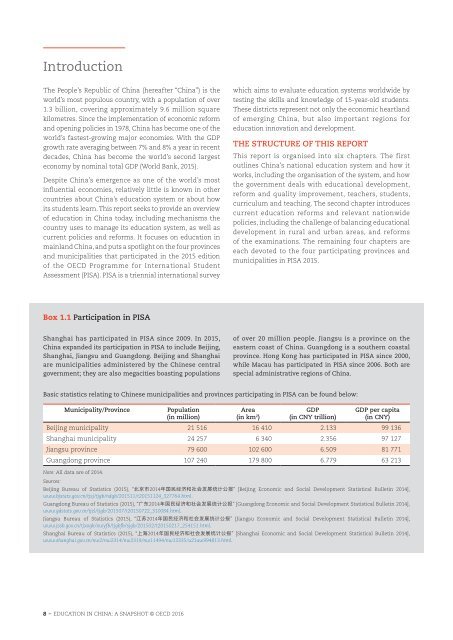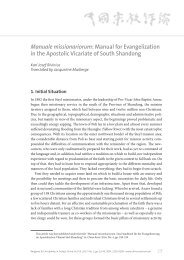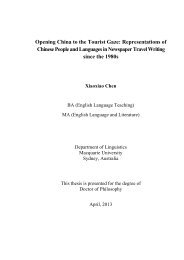EDUCATION IN CHINA
Education-in-China-a-snapshot
Education-in-China-a-snapshot
You also want an ePaper? Increase the reach of your titles
YUMPU automatically turns print PDFs into web optimized ePapers that Google loves.
Introduction<br />
The People’s Republic of China (hereafter “China”) is the<br />
world’s most populous country, with a population of over<br />
1.3 billion, covering approximately 9.6 million square<br />
kilometres. Since the implementation of economic reform<br />
and opening policies in 1978, China has become one of the<br />
world’s fastest-growing major economies. With the GDP<br />
growth rate averaging between 7% and 8% a year in recent<br />
decades, China has become the world’s second largest<br />
economy by nominal total GDP (World Bank, 2015).<br />
Despite China’s emergence as one of the world’s most<br />
influential economies, relatively little is known in other<br />
countries about China’s education system or about how<br />
its students learn. This report seeks to provide an overview<br />
of education in China today, including mechanisms the<br />
country uses to manage its education system, as well as<br />
current policies and reforms. It focuses on education in<br />
mainland China, and puts a spotlight on the four provinces<br />
and municipalities that participated in the 2015 edition<br />
of the OECD Programme for International Student<br />
Assessment (PISA). PISA is a triennial international survey<br />
which aims to evaluate education systems worldwide by<br />
testing the skills and knowledge of 15-year-old students.<br />
These districts represent not only the economic heartland<br />
of emerging China, but also important regions for<br />
education innovation and development.<br />
THE STRUCTURE OF THIS REPORT<br />
This report is organised into six chapters. The first<br />
outlines China’s national education system and how it<br />
works, including the organisation of the system, and how<br />
the government deals with educational development,<br />
reform and quality improvement, teachers, students,<br />
curriculum and teaching. The second chapter introduces<br />
current education reforms and relevant nationwide<br />
policies, including the challenge of balancing educational<br />
development in rural and urban areas, and reforms<br />
of the examinations. The remaining four chapters are<br />
each devoted to the four participating provinces and<br />
municipalities in PISA 2015.<br />
Box 1.1 Participation in PISA<br />
Shanghai has participated in PISA since 2009. In 2015,<br />
China expanded its participation in PISA to include Beijing,<br />
Shanghai, Jiangsu and Guangdong. Beijing and Shanghai<br />
are municipalities administered by the Chinese central<br />
government; they are also megacities boasting populations<br />
of over 20 million people. Jiangsu is a province on the<br />
eastern coast of China. Guangdong is a southern coastal<br />
province. Hong Kong has participated in PISA since 2000,<br />
while Macau has participated in PISA since 2006. Both are<br />
special administrative regions of China.<br />
Basic statistics relating to Chinese municipalities and provinces participating in PISA can be found below:<br />
Municipality/Province<br />
Population<br />
(in million)<br />
Area<br />
(in km 2 )<br />
GDP<br />
(in CNY trillion)<br />
GDP per capita<br />
(in CNY)<br />
Beijing municipality 21 516 16 410 2.133 99 136<br />
Shanghai municipality 24 257 6 340 2.356 97 127<br />
Jiangsu province 79 600 102 600 6.509 81 771<br />
Guangdong province 107 240 179 800 6.779 63 213<br />
Note: All data are of 2014.<br />
Sources:<br />
Beijing Bureau of Statistics (2015), “ 北 京 市 2014 年 国 民 经 济 和 社 会 发 展 统 计 公 报 ” [Beijing Economic and Social Development Statistical Bulletin 2014],<br />
www.bjstats.gov.cn/tjsj/tjgb/ndgb/201511/t20151124_327764.html.<br />
Guangdong Bureau of Statistics (2015), “ 广 东 2014 年 国 民 经 济 和 社 会 发 展 统 计 公 报 ” [Guangdong Economic and Social Development Statistical Bulletin 2014],<br />
www.gdstats.gov.cn/tjzl/tjgb/201507/t20150722_310084.html.<br />
Jiangsu Bureau of Statistics (2015), “ 江 苏 2014 年 国 民 经 济 和 社 会 发 展 统 计 公 报 ” [Jiangsu Economic and Social Development Statistical Bulletin 2014],<br />
www.jssb.gov.cn/tjxxgk/xwyfb/tjgbfb/sjgb/201502/t20150217_254151.html.<br />
Shanghai Bureau of Statistics (2015), “ 上 海 2014 年 国 民 经 济 和 社 会 发 展 统 计 公 报 ” [Shanghai Economic and Social Development Statistical Bulletin 2014],<br />
www.shanghai.gov.cn/nw2/nw2314/nw2319/nw11494/nw12335/u21aw994813.html.<br />
8 – <strong>EDUCATION</strong> <strong>IN</strong> CH<strong>IN</strong>A: A SNAPSHOT © OECD 2016





